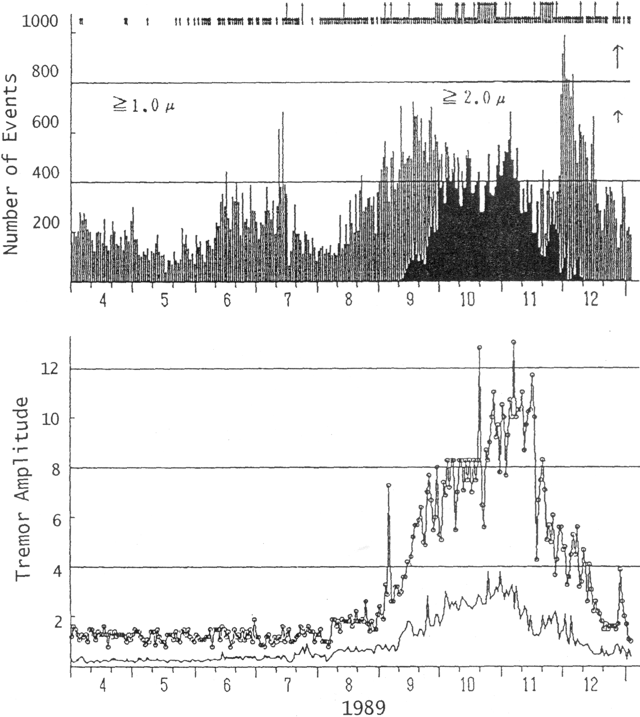Report on Asosan (Japan) — December 1989
Scientific Event Alert Network Bulletin, vol. 14, no. 12 (December 1989)
Managing Editor: Lindsay McClelland.
Asosan (Japan) Ash emission and seismicity decline
Please cite this report as:
Global Volcanism Program, 1989. Report on Asosan (Japan) (McClelland, L., ed.). Scientific Event Alert Network Bulletin, 14:12. Smithsonian Institution. https://doi.org/10.5479/si.GVP.SEAN198912-282110
Asosan
Japan
32.8849°N, 131.085°E; summit elev. 1592 m
All times are local (unless otherwise noted)
Activity was less vigorous in December than in November, with only three recorded explosions (see table 4), bringing the year's total to 39. Minor ash emission was observed almost daily. A total of 755 g/m2 of ash was deposited at AWS. The number of isolated tremor episodes recorded by a seismometer at AWS decreased in late December (figure 16). The amplitude of continuous tremor declined to a level similar to that of early September (figures 17 and 18). Rumbling was slightly audible at AWS during the month.
 |
Figure 17. Daily number of isolated volcanic tremor episodes (top) and daily maximum and mean amplitudes of continuous tremor (bottom) at Aso, April-December 1989. Courtesy of JMA. |
Geological Summary. The 24-km-wide Asosan caldera was formed during four major explosive eruptions from 300,000 to 90,000 years ago. These produced voluminous pyroclastic flows that covered much of Kyushu. The last of these, the Aso-4 eruption, produced more than 600 km3 of airfall tephra and pyroclastic-flow deposits. A group of 17 central cones was constructed in the middle of the caldera, one of which, Nakadake, is one of Japan's most active volcanoes. It was the location of Japan's first documented historical eruption in 553 CE. The Nakadake complex has remained active throughout the Holocene. Several other cones have been active during the Holocene, including the Kometsuka scoria cone as recently as about 210 CE. Historical eruptions have largely consisted of basaltic to basaltic-andesite ash emission with periodic strombolian and phreatomagmatic activity. The summit crater of Nakadake is accessible by toll road and cable car, and is one of Kyushu's most popular tourist destinations.
Information Contacts: JMA.


